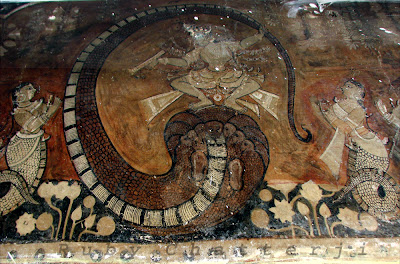WALL FRESCOES IN NEED OF LOVE & CARE
Note : Link for Part I : http://przmm.blogspot.in/2011/03/sri-kumaram-temple-at-srikakulamap.html
Not many have heard of the wall-frescoes of this temple at Srikakulam, though well-attended by devotees. At least not those who surf internet before visiting a place of tourist interest. But, a visit to this temple - which was rebuilt at least 700 years ago - without good time spent on the frescoes in the long 'parikrama' around the temple will be improper. The temple authorities have devoted just one line to the frescoes of this temple in the plaque outside which ,in my opinion, is unfair !
A good part of these frescoes are devoted to KrsnaLeela. Also, several manifestations of Vishnu. Unsupervised white-washing , loosely hanging electrical wires and a general lack of appreciation caused deterioration of this heritage art. I have not been to Lepakshi temple , but, there - it appears from what I found in the internet - the frescoes occupy much more a place of pride than at Sri Kurmam temple .
Note : Link for Part I : http://przmm.blogspot.in/2011/03/sri-kumaram-temple-at-srikakulamap.html
Krsna taming snake 'Sudarsana'-a cursed 'Vidhyadhara'.
 |
| 'Vastra - haran' - Krsna has taken away the clothes of Gopis, bathing in the Yamuna, on tree-top.Gopis are requesting Krsna not to torment them ! |
8th figure in this procession is Krsna, probably accompanied by Nanda. Who are the aristocratic persons leading the procession !
(Note - I could not find a matching 'story' in 'SriMadbhagabat')
'Kaliya Daman' - Taming of 'Kaliya'
Above was taken after shifting hanging strands of electric wire from the frame of the photo. One will feel bad if I post a photo of the total frame of this fresco. It was 16/02/2011 when we were at Sri Kurmam temple. We learnt that shortly a team from ASI will come to Srikakulam to initiate a process of reviving the frescoes. Hope the task is in progress, if not completed.
'Varah avatata' of Vishnu - an unusual depiction !
Blow-up
reveals the Earth - not a female figure ! - resting on right elbow of
'Varah' while he tramples Hiranyaksha (?) into sea-water
with his right foot !
It is indeed unfortunate , as the viewer must have noted by now, the blotches of lime-wash has caused serious problem to these frescoes.Very little of the painting above was visible to naked eye. Considerable enhancement has given a reasonable appearance to this one. While I have more photos in my HDD , I shall end with one of Siva riding Nandi. More on some other occasion.
Siva riding Nandi , Parvati accompanying him. He has raised his trident whereas two of his foot-soldiers - quite obscure though -
are found to wield swords.
Note - Regd. the last fresco, pl read Amol N banker's comment & my reply too.























